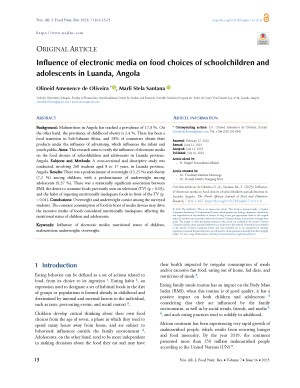Main Article Content
Influence of electronic media on food choices of schoolchildren and adolescents in Luanda, Angola
Abstract
Background: Malnutrition in Angola has reached a prevalence of 17.3 %. On the other hand, the prevalence of childhood obesity is 2.4 %. There has been a food transition in Sub-Saharan Africa, and 28% of consumers obtain their products under the influence of advertising, which influences the infant and youth public. Aims: This research aims to verify the influence of electronic media on the food choices of schoolchildren and adolescents in Luanda province, Angola. Subjects and Methods: A cross-sectional and descriptive study was conducted, involving 268 students aged 8 to 17 years, in Luanda province, Angola. Results: There was a predominance of overweight (15.25 %) and obesity (7.2 %) among children, with a predominance of underweight among adolescents (9.37 %). There was a statistically significant association between BMI, the desire to consume foods previously seen on television (TV) (p = 0.03), and the habit of ingesting nutritionally inadequate foods in front of the TV (p = 0.01). Conclusions: Overweight and underweight coexist among the surveyed students. The constant consumption of food in front of media devices may drive the excessive intake of foods considered nutritionally inadequate, affecting the nutritional status of children and adolescents.






